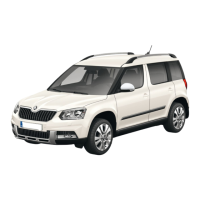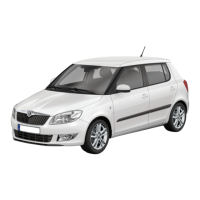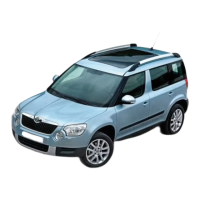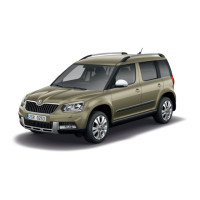›
Fold the middle seat backrest forward » page 81, Rear seats.
›
Place the empty through-loading bag in the gap between the front and rear
seats in such a way that the end of the bag with the zip lies in the boot.
›
Open the tailgate.
›
Push the skis into the through-loading bag from the boot » .
›
Close the through-loading bag.
Securing
›
Pull the securing belt with both lock tongues out of the pocket of the
through-loading bag.
›
Insert the lock tongues
A
» Fig. 92 in the belt locks of the rear middle seat
belt
C
, first on the one side and then on the other side.
›
Place the securing belt in the middle of the skis between the heel and the tip
of the bindings and pull the securing belt tight at the free end of the belt
B
.
WARNING
■
After placing the skis into the through-loading bag, you must secure the
through-loading bag with the securing belt.
■
The securing belt must hold the skis tight.
■
Ensure that the securing belt for skis grasps the middle between the tip
and the heel element of the binding (see also imprint on the through-load-
ing bag).
■
The total weight of the skis which are transported must not exceed 10 kg.
CAUTION
Never fold and pack the through-loading bag moist.
Note
■
The through-loading bag is designed for the transportation of two pairs of
skis.
■
Place the skis and sticks in the through-loading bag with the tips facing to
the rear.
■
If there are several pairs of skis in the through-loading bag, ensure that the
bindings are positioned at the same height.
Luggage compartment
Introduction
This chapter contains information on the following subjects:
Fastening elements
95
Fixing nets 96
Foldable hook 96
Fastening bar with sliding hook 96
Flexible storage compartment 97
Floor covering on both sides 97
Luggage compartment cover 97
Net partition 98
Storage compartments 99
Removable storage box 99
Removable light 100
Class N1 vehicles 100
Please observe the following for the purpose of maintaining good handling
characteristics of your vehicle:
›
Distribute loads as evenly as possible.
›
Place heavy objects as far forward as possible.
›
Attach the items of luggage to the lashing eyes or by using the fixing
nets » page 95.
In the event of an accident, even small and light objects gain so much kinetic
energy that they can cause severe injuries.
The magnitude of the kinetic energy is dependent on the speed at which the
vehicle is travelling and the weight of the object.
Example: In the event of a frontal collision at a speed of 50 km/h, an object
with a weight of 4.5 kg produces an energy, which corresponds to 20 times its
own weight. This means that it results in a weight of approx. 90 kg “ ”.
WARNING
■
Store the objects in the boot and attach them to the lashing eyes.
■
Loose objects can be thrown forward during a sudden manoeuvre or in
case of an accident and can injure the occupants or other road users.
94
Using the system

